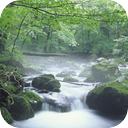(short preview of full seamless looping track)
Forest Stream
This product is not available in the selected currency.
In Stock
Backordered
Out of Stock
Description
The sweet smell of fresh water wafts through the sunny forest so strongly that every creature within a hundred miles could eventually find this stream, even by starlight alone. You take a seat and surrender yourself to the absolute control that clean, drinkable water has over every part of your world. Without the grace of heaven and the gift of the ground, you would not be here today. Streams typically derive most of their water from precipitation in the form of rain and snow. Most of this water re-enters the atmosphere by evaporation from soil and water bodies, or by the evapotranspiration of plants. Some of the water proceeds to sink into the earth by infiltration and becomes groundwater, much of which eventually enters streams. Some precipitated water is temporarily locked up in snow fields and glaciers, to be released later by evaporation or melting. The rest of the water flows off the land as runoff, the proportion of which varies according to many factors, such as wind, humidity, vegetation, rock types, and relief. This runoff starts as a thin film called sheet wash, combined with a network of tiny rills, together constituting sheet runoff; when this water is concentrated in a channel, a stream has its birth. To qualify as a stream it must be either recurring or perennial. Recurring streams have water in the channel for at least part of the year. A stream of the first order is a stream which does not have any other stream feeding into it. When two first-order streams come together, they form a second-order stream. When two second-order streams come together, they form a third-order stream. Streams of lower order joining a higher order stream do not change the order of the higher stream. Thus, if a first-order stream joins a second-order stream, it remains a second-order stream. It is not until a second-order stream combines with another second-order stream that it becomes a third-order stream.
This sound uses the following file from Freesound: http://www.freesound.org/samplesViewSingle.php?id=126281
Opps
Sorry, it looks like some products are not available in selected quantity.



